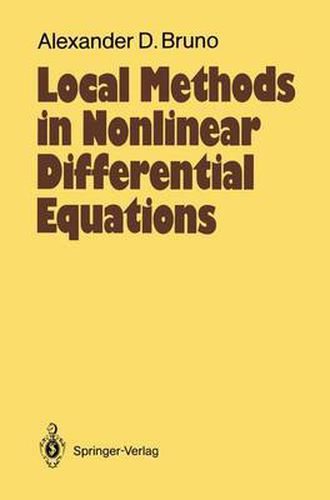Readings Newsletter
Become a Readings Member to make your shopping experience even easier.
Sign in or sign up for free!
You’re not far away from qualifying for FREE standard shipping within Australia
You’ve qualified for FREE standard shipping within Australia
The cart is loading…






This title is printed to order. This book may have been self-published. If so, we cannot guarantee the quality of the content. In the main most books will have gone through the editing process however some may not. We therefore suggest that you be aware of this before ordering this book. If in doubt check either the author or publisher’s details as we are unable to accept any returns unless they are faulty. Please contact us if you have any questions.
The method of normal forms is usually attributed to Poincare although some of the basic ideas of the method can be found in earlier works of Jacobi, Briot and Bouquet. In this book, A.D.Bruno gives an account of the work of these mathematicians and further developments as well as the results of his own extensive investigations on the subject. The book begins with a thorough presentation of the analytical techniques necessary for the implementation of the theory as well as an extensive description of the geometry of the Newton polygon. It then proceeds to discuss the normal form of systems of ordinary differential equations giving many specific applications of the theory. An underlying theme of the book is the unifying nature of the method of normal forms regarding techniques for the study of the local properties of ordinary differential equations. In the second part of the book it is shown, for a special class of equations, how the method of normal forms yields classical results of Lyapunov concerning families of periodic orbits in the neighborhood of equilibrium points of Hamiltonian systems as well as the more modern results concerning families of quasiperiodic orbits obtained by Kolmogorov, Arnold and Moser. The book is intended for mathematicians, theoretical mechanicians, and physicists. It is suitable for advanced undergraduate and graduate students.
$9.00 standard shipping within Australia
FREE standard shipping within Australia for orders over $100.00
Express & International shipping calculated at checkout
This title is printed to order. This book may have been self-published. If so, we cannot guarantee the quality of the content. In the main most books will have gone through the editing process however some may not. We therefore suggest that you be aware of this before ordering this book. If in doubt check either the author or publisher’s details as we are unable to accept any returns unless they are faulty. Please contact us if you have any questions.
The method of normal forms is usually attributed to Poincare although some of the basic ideas of the method can be found in earlier works of Jacobi, Briot and Bouquet. In this book, A.D.Bruno gives an account of the work of these mathematicians and further developments as well as the results of his own extensive investigations on the subject. The book begins with a thorough presentation of the analytical techniques necessary for the implementation of the theory as well as an extensive description of the geometry of the Newton polygon. It then proceeds to discuss the normal form of systems of ordinary differential equations giving many specific applications of the theory. An underlying theme of the book is the unifying nature of the method of normal forms regarding techniques for the study of the local properties of ordinary differential equations. In the second part of the book it is shown, for a special class of equations, how the method of normal forms yields classical results of Lyapunov concerning families of periodic orbits in the neighborhood of equilibrium points of Hamiltonian systems as well as the more modern results concerning families of quasiperiodic orbits obtained by Kolmogorov, Arnold and Moser. The book is intended for mathematicians, theoretical mechanicians, and physicists. It is suitable for advanced undergraduate and graduate students.